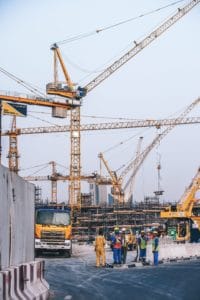Industrial Maintenance Safety w/ Natural Ventilators
When it comes to building maintenance, safety is always the top concerns. Even a project that involves green retrofitting for ventilation can provide challenges. Workers must be careful when using cranes, ladders, scaffolds, electricity, etc. Any powerful equipment than can tip over, fall, break, or otherwise hurt people. That’s why the Occupational Safety Health Administration (OSHA) has developed safety standards to ensure industrial maintenance safety.
Certifications

Construction workers require certifications by accredited testing entities. Certification requires testing that covers equipment and personnel safety. Enforcement, as well as record keeping and evaluation, is handled by the Occupational Safety and Health Administration (OSHA). Committees from organizations such as American Society of Safety Engineers (ASSE), American National Standards Institute (ANSI) and American Society of Mechanical Engineers (ASME) developed these standards. At Moffitt our team goes through extensive training and certifications and are experts in industrial ventilation.
Equipment
Industrial machinery like electric turbines or roof fan require regular inspection and maintenance to uphold safety standards. Unlike electric turbines, natural ventilators are modest maintenance and require little to no repairs over their lifetime. People who want to install their own equipment should pay close attention to industrial maintenance safety manuals. These manuals are provided by their respective equipment manufacturers.
Cranes & Lifts
Cranes and personnel lifts are among the most dangerous equipment used in construction or installation, but OSHA’s enforcement of safety standards the past few decades has reduced industrial injuries. Crane operators must now pass rigorous written and practical testing by ANSI-accredited organizations. The crane industry has improved its safety partly due to requirements that operators must use crane manufacturer “load charts” that determine the lifting capacity in terms of weight for each individual crane based on boom angles and boom lengths. Booms are the long extensions from cranes that allow the machines to lift heavy objects.
Part of a construction crew can include signal persons who direct crane operators when lifting objects that may not be visible to the operator. The signal person must stand in a position where they can view both the object being lifted and the crane operator. The signal person uses hand signals for movements such as lifting, lowering, or stopping. Each member of the crew must meet before a work project begins and agree on communication signals. Another type of signal communication involves the use of radios. Finally, limit area access to authorized personnel only when cranes are in use.
Industrial Maintenance Inspections
Equipment inspections make sure that the equipment functions properly as it ages. Inspect HVAC systems regularly as air filters collect a lot of dirt and dust that can mix in with air flow. Replace filters regularly to decrease indoor air pollution. Consequently, this can cause health problems such as allergies and respiratory damage.
Natural ventilators are much different than conventional HVAC systems. They require less maintenance, incur fewer operating costs, and require less upkeep. This results in fewer trips to the roof and reduces the risks of falling and working with hazardous equipment. Of course, the more an installer or inspector adheres to safety standards, the easier it is to prevent accidents or damage.
The first step in any job with a crane is to inspect the work area. This applies to all industrial equipment involving roof installations. Make sure everything is safe before starting work. Before hoisting, inspect the ground beneath the crane. The soil needs to be able to support the weight of the crane. Many cranes weigh several tons, so this step is vital. Another safety consideration is that cranes must keep a certain distance from electric power lines, which can cause electric shock if the crane encounters them.
Worker Safety
Industrial maintenance safety is the priority when working in high or dangerous places. Below is a list of worker safety requirements that all Moffitt contractors must follow.
- Technicians must wear proper safety attire and hard hats for their personal protection.
- Shoes must have hard soles and be in good working condition.
- All crew members must wear long pants. In some facilities, crew members must wear long sleeves as well.
- Avoid drugs or alcohol. Impairment can be deadly.
- Wear full body harnesses or other fall-protection gear as required.
- Secure all ladders before use.
- Carry first aid kits.
- Finally, report all unsafe conditions to their supervisors.
